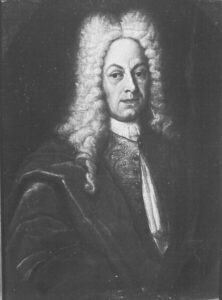
JOHANN THOMAS HENSING
30 August 1683-27 August 1726

Johann Thomas was a son of Susanna and Matthias Hensing, a surgeon. He married Maria Juliana Nitzsch, a daughter of a vice-chancellor of the University of Giessen, they had a son Friedrich Wilhelm and a daughter Juliana Johannetta.
At the age of 18, Johann Thomas enrolled in the philosophy faculty in Leipzig. His plan to study theology was interrupted by a serious illness. Then, he enrolled as a student at the medical faculty in Leipzig in 1704, and later at the University of Giessen, where he remained until the end of his life, except some years in Frankfurt.
Firt, Hensing was doctor in Wetzlar and Giessen in 1706 and in Frankfurt am Main in 1710, and private lecturer in medicine at the university in 1712. In 1717 he was appointed associate professor, and six years later he was full professor of natural and chemical philosophy. He was fortunate to have Georg Christoph Möller as a mentor in chemistry classes as his laboratory enabled the young professor to carry out a study of the chemical composition of the brain. His first results were published in 1719 under the title “Cerebri Examen Chemicum ex eodemque Phosphorem singularem omnia inflammabilia accendentem“.
Hensing chose the brain as an object of study because he recognized this organ as the true throne of the soul and the seat of wisdom. He published the results of his study in Latin under the title: The chemical study of the brain and the unique phosphorus from which it ignites all combustible substances.
Hensing’s analysis of the brain included liquids, solid components and ash. Examination of the ash revealed the presence of elemental phosphorus. By treating cattle brain with alum, Hensing obtained a powdery residue which was able to spontaneously ignite. This was a highly original discovery because this element had been discovered 50 years earlier in Germany, but in human urine, from which it was produced commercially, and in the ashes of plants.
Although its discovery was subsequently mentioned by some authors, there is no reference to it in the writings of the most popular chemists.
Far later, Ludwig Thudichum noted that Hensing’s discovery was clearly the earliest chemical analysis to study brain matter. The discovery of phosphorus in the brain was particularly intriguing even in the 19th century because its properties, because it glowed in the dark and, when exposed to air it emitted heat. These properties suggested a relationship to thinking and the production of ideas. Many years later, the French physician and philosopher PJ Cabanis (1757–1808) proposed that one of these functions was related to the mental status of the individual. This idea persisted in one form or another for many years (TL Sourkes, J. Hist Neurosci 1998, 7, 108). Even Couerbe regarded phosphorus as a key element in the workings of the brain, claiming that the brains of idiots were deficient in phosphorus, whereas those of insane persons contained an excess.
Jacob Moleschott (1822–1893) (Fig. 3), a physiologist among the most widely known and respected of nineteenth century European scientists wrote that ‘‘the brain cannot exist without phosphorus-containing fat, and because the existence of the brain is dependent on this fat, so also is thought tied to brain activity.’’
DISPERSIVE LIQUID-LIQUID MICROEXTRACTION
Lire la suiteDevenez membre et participez au développement de la Lipidomique au XXIème siècle.
S'inscrire